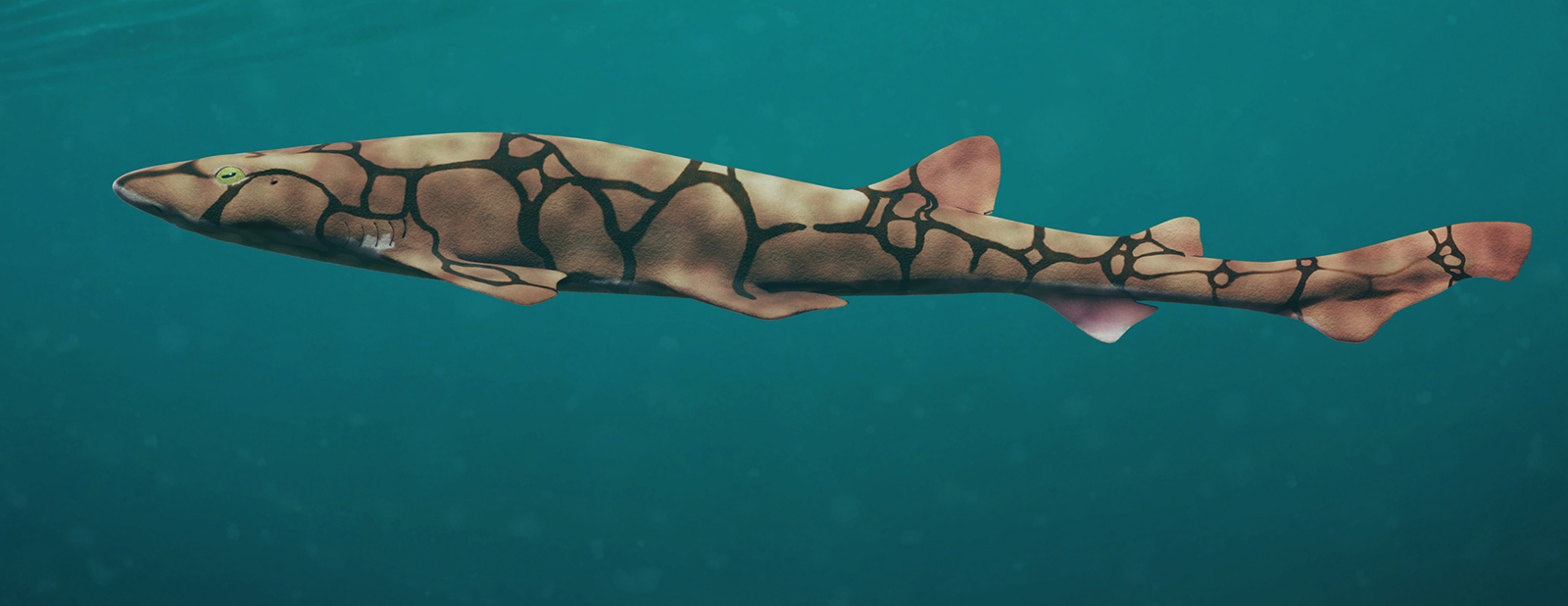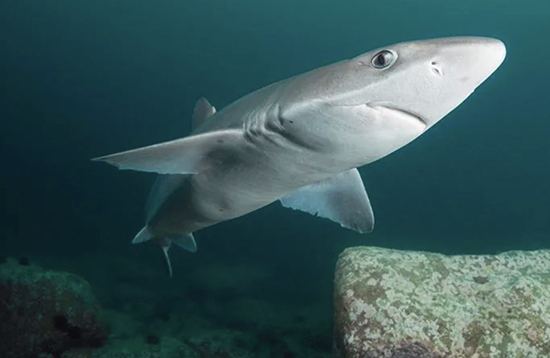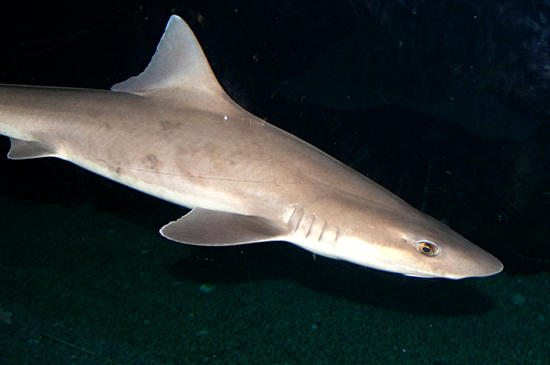Plentiful and Ferocious Shark Lurks In Local Waters
January 29, 2024
The great white shark gets all the coverage, but another shark species, with a far-less cool-sounding name, dominates local waters, at least in sheer numbers.
The Atlantic spiny dogfish (Squalus acanthias) is the poor cousin to the more-alluring sharks of greater size and fame. They have sharp, albeit little, teeth, are ferocious predators, and are opportunistic feeders. They like to devour mackerel and herring.
Spiny dogfish can arch their backs and inject venom into predators from their dorsal spines. They are harmless to humans — although a jab from one of their dorsal spines could get infected — but they have been observed biting through fishing nets to get at prey, according to the National Marine Sanctuary Foundation.
They migrate into local waters in the warmer months, and some remain through the winter. But most stocks are highly migratory, and they spawn in the winter in offshore waters. Spiny dogfish females have between two and 12 eggs per spawning season.
The spiny dogfish is the most abundant shark in the western North Atlantic, but they aren’t the only species of dogfish swimming in local waters. Like the spiny version, the smooth dogfish or dusky smooth-hound (Mustelus canis) can be found in Narragansett Bay. The chain dogfish (Scyliorhinus retifer) can’t. It’s also, confusingly, known as a chain catshark.
This small, biofluorescent dog/cat shark can be found in Rhode Island Sound, at a depth of 180 or so feet, according to Adam Kovarsky, Save The Bay’s lead aquarist. The average depth of Narragansett Bay is only about 25 feet, he noted.
Save The Bay’s Newport aquarium has four smooth dogfish, and Kovarsky runs a breeding program for the chain dogfish. Born in captivity, the juveniles, at about a year of age, are released into Rhode Island Sound. The aquarium currently houses four breeding pairs of chain dogfish. Kovarsky said the breeding adults are swapped out annually.
“They live just fine in shallow water in our aquarium, but they reside in deeper water,” he said. “And I think part of that is they’re extremely well adapted to low light. Their nighttime vision is ten times better than a cat’s night vision, and a cat’s vision is way better than ours. So at night it basically looks like daytime to us.”
Since the Save The Bay program started in 2015, some 700 juvenile chain dogfish have been released into Rhode Island Sound, according to Kovarsky.
The three species share the same surname but these sharks aren’t closely related. At 1.5 feet, the chain dogfish is the smallest of the local trio. Spiny dogfish males grow up to 3.5 feet and females grow up to 4 feet, with a maximum weight of 22 pounds. Smooth dogfish are similar in size and weight to their spiny cousins.

While spiny dogfish are voracious predators, smooth and chain are both primarily scavengers. Their mouths don’t contain sharp, hunting teeth. In fact, according to Kovarsky, smooth dogfish have crushing plates, almost like molars, in the back of their jaws. They use them to eat crustaceans and mollusks.
So why are spiny dogfish the species most people have heard of? Kovarsky shared his theory.
“They’re more like a classic shark in a lot of ways,” he said. “Like when people think of a shark you know they have the sharp teeth. People tend to gravitate towards dangerous things because it’s interesting. [But] spiny dogfish are very safe to be around. You literally have to get your finger in their mouth like very purposely.”
(The click-bait headline plays to that danger.)
Like all sharks, spiny dogfish grow slowly, mature late in life, and live a long time — 35-40 years in their case. Besides humans, dogfish are preyed upon by cod, red hake, goosefish, larger sharks, seals, and each other.

Spiny dogfish doesn’t have an appetizing ring to it, so about a decade ago, in an attempt to make the fish sound more appealing, the Cape Cod Commercial Fishermen’s Alliance, New England fishers, and conservationists rebranded it as “Cape shark.” This ongoing effort to create local demand for a plentiful regional species, which grew in number with the collapse of the cod fishery, still hasn’t taken hold, but the dogfish fishery is the largest shark fishery in the United States.
That’s because there is a nonlocal market for the shark. In Britain, it’s wrapped in newspaper as the key ingredient in a popular restaurant staple. Millions of pounds are harvested here annually, frozen, and sent overseas.
The dogfish fishery operates from Maine to Florida and from inshore to offshore waters on the edge of the continental shelf. The fishery primarily uses bottom gillnets, with lesser amounts caught by trawls and hook gear, according to NOAA Fisheries.
The fishery is managed jointly by the Mid-Atlantic Fishery Management Council (MAFMC) and the New England Fishery Management Council, with the MAFMC in the lead to develop management actions that impact the fishery in federal waters. An Atlantic spiny dogfish fishery management plan was implemented in 2000 in response to the classification of the stock as overfished in 1998.
The fishery’s management plan includes all federal East Coast waters. Harvest is primarily controlled through daily trip limits and an annual quota that closes the fishery in federal waters if the quota is reached.
With its mild white boneless flesh, dogfish, said Kate Masury, executive director of Eating with the Ecosystem, is less flaky than cod but just as delicious. It also has a milder taste, she added.
Eating with the Ecosystem, a Rhode Island-based nonprofit that promotes a place-based approach to sustaining New England’s wild seafood, is working with consumers, chefs, suppliers, processors, and fishers to build a local market for dogfish.
The region’s seafood consumption is heavily dominated by five classic and diminishing New England species: lobster, sea scallops, soft-shell clams, cod, and haddock. Oysters have also become a popular seafood, thanks to a growing number of aquaculture operations.

Many of the most abundant species off the New England coast, including spiny and smooth dogfish, skate, whiting, and Atlantic butterfish, which is often caught as bycatch in the growing squid fishery, are hard to find at seafood counters or on menus.
Masury recently told ecoRI News that only a few local places actually serve it, including Dune Brothers in Providence (Cape shark on the menu), and few fishmongers handle it. She said Boston-based Red’s Best buys most of the dogfish caught in local waters.
“They’re one of the few dealers that will buy it and process it, because sharks, like dogfish, if you don’t handle them correctly, it can definitely be not the best smelling and not the best taste, and it can have a shorter shelf life,” Masury said.
Unprocessed shark meat may have a strong odor of ammonia, due to the high urea content that develops as the fish decomposes. The urea content and ammonia odor can be reduced by marinating the meat in lemon juice, vinegar, milk, or salt water.
“U.S. wild-caught Atlantic spiny dogfish is a smart seafood choice because it is sustainably managed and responsibly harvested under U.S. regulations,” according to NOAA Fisheries.
The fishery has been certified sustainable by the Marine Stewardship Council since 2012. The dusky smooth-hound fishery is also stable, according to fishery officials.
The Atlantic spiny dogfish is a small demersal (groundfish) shark of temperate continental shelf seas worldwide — the Pacific version is considered a separate species (Squalus suckleyi).
Thousands swim together in packs, making them easy for fishers to catch. Regional and local management plans are also in place, including in Rhode Island, where commercial operators can land 7,500 pounds a day.
Dogfish, however, doesn’t pay the bills like cod once did, which is why few fishers focus solely on these sharks. Masury said a small boat based out of Point Judith fishes for dogfish and a few Cape Cod fishers out of Chatham also fish for the shark.
For decades, spiny dogfish were an annoyance to local fishers. They were a “trash fish” with little value that often ended up clogging their nets. The large spines on their fins made them a pain (sometimes literally) to throw back, and they eat pretty much everything smaller than them, including juvenile cod.
The industry’s attitude toward the aggressive and relentless predators has since changed, with the disappearance of cod and Europe’s appetite for fish and chips and beer snacks. Fishmongers use dogfish “belly flaps” for fish and chips in England and as a popular beer garden snack called “schillerlocken” in Germany.
In the 2022-23 fishing season, commercial landings of Atlantic spiny dogfish were estimated at 12.6 million pounds, while recreational harvest was estimated at 211,608 pounds, according to the Atlantic States Marine Fisheries Commission (ASMFC). Commercial landings continue to be mostly female dogfish, with female landings comprising about 98% of the total commercial catch.
Discards have remained fairly stable, about 11 million pounds over the past decade and are expected to remain near that level in the future, according to ASMFC.
Prior to the Fishery Conservation and Management Act of 1976 — better known as the Magnuson-Stevens Fishery Conservation and Management Act — foreign fleets caught the majority of dogfish in U.S. waters, but U.S. fishers have had uncontested access for the past 48 years.




You state, “The fishery has been certified sustainable by the Marine Stewardship Council since 2012. The dusky smooth-hound fishery is also stable.
This is a wildly incorrect statement. For example, Brant Rock, MA port landed 6 million to 7 million pounds annually 2009 thru 2014. These past 10 years there are nearly zero landings. As we asked Pat Gerkel. forme NOAA chief in Gloucester GARFO, did they just disappear or were there sonar blasts and radical sound waves causing them to move elsewhere…southeast to cooler waters…Where is your data for current landings. The MSC is a farce…market based manipulative coralling is for the birds. Check your facts.
for the record these little savages are a royal pain in the ass. when fluke or cod fishing and using squid for bait, if these beasts are around they will out race any other fish to the bait. they swim in wolf packs. when you are reeling one in there are one to four more following it to the surface waiting their turn. they death roll in the fishing line and knot everything to hell. when they re on the gunwale they whip their tail and are very adept at sinking the dorsal spine into your forearm. i had one tear the skin away from the muscle in my forearm. they manage to set the hook in their jaw bone making it almost impossible to shake the hook loose usually necessitating cutting the jaw or ripping the hook loose with a pliers.
regarding their editability, i tried grilling a couple of steaks and they were terrible. the meat is mushy not flaky as some claim and it doesn t taste like mako or thresher. i don t know how the english eat it as fish and chips but then of course the english have never been know for their culinary talents.
for the record – the ammonia fumes that develop as the meat decomposes is not from the formation of urea, it s from the decomposition of urea, the first by-product of which is ammonia. sharks don t have kidneys so the urea which they produce is excreted through the skin. urea is basic thus the soaking in lemon juice or anything acidic helps to neutralize the urea.
bottom line the less of these annoyances there are the happier i am.
James Reardon- I am a commercial fisherman out of Brant Rock MA and can tell you the decrease in landings in our harbor has nothing to do with the sustainability of the fishery and everything to do with market forces and trucking costs.